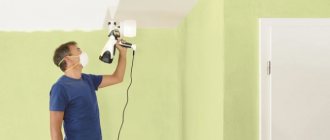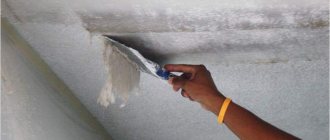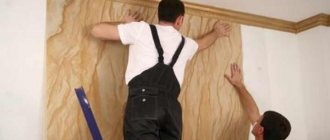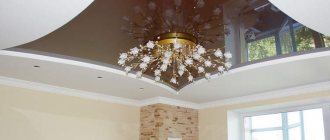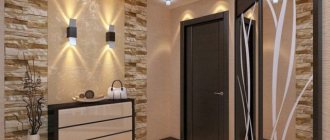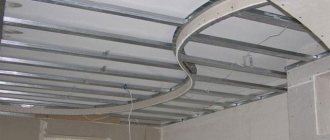The situation when the suspended ceiling sagged unexpectedly for the owners of the apartment is not something exceptional. But, even understanding the reasons and the presence of conditions due to which the ceiling finish suddenly turns from an absolutely flat state into a sail, customers most often find themselves unprepared for the problem of sagging fabrics and films.
Sagging of the canvas after flooding
Reasons for sagging stretch ceilings
It is necessary to distinguish between instantaneous and static sagging of the cladding; in the first case, a change in the geometry of the plane and sagging of the material occurs for a very short period of time, 2-3 seconds, no more. In the second case, the surface maintains a constant curvature for quite a long time; sometimes the sagging of the tension film remains even after reinstallation.
Bubble on the ceiling due to a gust of wind
There are only five main reasons:
- The stretch ceiling sags from the air. If there are no vents or ventilation windows in the ceiling space, then in windy weather with the windows open, it happens that the cladding sag can reach 6-7 cm. If the vinyl film bulges in bubbles several times a day, then sagging of the ceiling trim becomes inevitable;
- Leaking ceiling. Most often, moisture seeps through microcracks at the joints of concrete slabs and accumulates on the back side of the film. It happens that the reason that the vinyl ceiling sag is condensation accumulating on steel pipes hidden behind the tension fabric;
- Violation of installation technology or temperature conditions. If the polyvinyl chloride film was not heated during installation or was placed at an air temperature lower than +7°C;
- The wrong profile type or wall mounting method has been selected. In this case, the baguette moves away from the wall. It happens that the suspended ceiling sagged due to the pulling of the harpoon or bead from the groove lock;
- Destruction of wall cladding. The frame may come away from the vertical surface along with the plaster or drywall finish. Sometimes the sagging of a stretch ceiling is noticed after the plasterboard sheets begin to deform, or cracks appear in the plaster.
As a rule, before installing the decor, the concrete or wooden floor is carefully prepared for installation of the canvas. Seal and seal the cracks, blow out possible sources of cold, damp air with foam. If installed by experienced craftsmen, then the profile is selected and placed under a specific vinyl film, guided by the experience and recommendations of decor manufacturers.
Ventilation grid for film cladding
Therefore, the most common causes remain water leakage and air flow impacts when opening doors and windows. At the same time, sagging most often happens with vinyl ceilings. In tensile fabric structures, the air permeability of the material is so high that even in the strongest draft, pops and sagging of the facing fabric are very rare.
Foreign objects falling onto the film
Since the film is stretched below the rough ceiling (it cannot be otherwise), it is important what exactly is on this rough plane and how it is fixed there. And what the rough ceiling itself is made of also matters. For example, a rough wooden ceiling is insulated with bulk material such as glass wool, but this wool is not covered with film or isospan.
The cotton wool will fall onto the stretch ceiling. The material will begin to shine through its canvas, and over time it may push through a little. The same applies to wires that have fallen onto the film, once laid across the rough ceiling, but not securely fastened. Ceiling tiles from an old ceiling can also fall onto the film if they are left on it. An old and poorly secured ceiling plinth left under a tension structure can also fall onto the film and push through it.
Read also: Exfoliation in facial care
Standards for sagging stretch ceilings
The situation with the normatively established values of sagging of film ceiling cladding is quite unclear. On the one hand, SNiPs for the installation of membrane suspended ceilings do not have clearly defined requirements for the permissible slope. On the other hand, in the specifications of German and French manufacturers there is a standard according to which a horizontal sag of more than 1% is considered a sign of a violation of the installation technology.
For your information! This means that in a room of 3x6 m, a sagging of 1% will be 6-7 cm. Visually, the human eye, with some experience, is able to distinguish the difference in positions in a situation where the suspended ceiling sagged by 2-3 cm over 5 m of length.
In reality, sagging of a stretch ceiling is a normal situation if the sagging does not go beyond 0.1-0.2%. If the material sag by a large amount, then the appearance of the cladding is lost; for smaller values, the tearing force acting on the frame increases significantly.
How to deal with the problem
If cases of violation of installation technology are identified, then you need to exercise your right to a guarantee. As a rule, when concluding a contract for the installation of suspended ceilings, it is provided by serious companies. They correct all defects at their own expense.
Advice: carefully read the information in the contract. Even with the one included in the additions in small print. This is where “pitfalls” are often hidden. Do not be lazy to spend time and thereby insure yourself against the dishonesty of the performer.
Emergency situations
If the ceiling is flooded with neighbors from above, the procedure should be as follows:
- Immediately turn off the power to your apartment or house. Water can accumulate under the chandelier, which will sooner or later lead to a short circuit.
- After the lights are turned off, call suspended ceiling specialists. Here you or your pest neighbors pay for the company’s services (if you agree). Specialists carefully dismantle the panel and drain the water. After complete drying, the craftsmen will return the stretch ceiling to its usual position.
- The same actions are performed if old construction debris has fallen onto the canvas from the slab. Before re-tensioning the ceiling, it is better to carefully treat the floor slabs and clean them.
Now you know why the suspended ceiling sags in a room , and you understand how to fix the problem if an incident occurs.
Write in the comments: Has your suspended ceiling ever sagged?
What to do if the suspended ceiling sag
The procedure for eliminating the consequences of geometry violations is approximately the same in all cases:
- In the presence of craftsmen, the nature of the damage is examined;
- The reason why the ceiling sagged is determined; a repair estimate is drawn up;
- The decor is reinstalled at the expense of the guilty party.
You can, of course, try to repair the damage yourself, especially in a situation where the ceiling is sagging on the eve of an important event, and there is simply no time to deal with careless neighbors or craftsmen.
If the harpoon comes off, you can seal part of the edge with glue
Removing water
If the profile is sagging due to flooding, then there is no point in waiting for the experts to arrive. The longer the stretch vinyl sheet is under load, the higher the risk of hernias forming on the surface of the cladding.
Water is drained only with a tube through the hole for the lamp
To remove water that has accumulated on the ceiling, it is best to disassemble the lamp or remove a small section of the film on the frame. Next, using a rubber tube and container, you need to drain as much water as possible. Reinstallation and alignment of the decor will be carried out by specialists.
We tidy up the profile and walls
If the walls cannot withstand the tension of the vinyl film, then you will need to move the frame to the ceiling surface. Usually, re-drilling the attachment points to a greater depth does not significantly improve the situation, especially if the ceiling decor is sagging on frame-type walls or those assembled from gypsum blocks.
Fixing problems with harpoons and profile
There is only one way to eliminate the problem: you need to remove the canvas and reinstall the baguettes on the lining profile. Most often, the ceiling sagged due to deformation or separation of the harpoon. The linings will reduce the internal size of the frame, which will allow you to re-glue the harpoon tape, and thereby reinstall the tension decor. In this case, an additional ceiling plinth is glued to cover the lining profile.
Additional dowels can be installed in a small area
How to fight the wind
Vinyl film is absolutely impenetrable to air flow. If the ceiling is sagging, it means that the ventilation system in the room clearly requires improvement. To avoid such problems in the future, it is enough to install two ventilation grilles on the suspended ceiling. Sometimes the problem disappears after installing several additional ceiling lights.
Incorrect installation of baguette
A sagging ceiling of 5 cm or more indicates serious violations in the installation of the molding. Thus, the tension may weaken as a result of the gap formed between the wall and the fastening bar. Sometimes, the distance between the baguette and the wall is the result of poor-quality fasteners.
The solution to the problem is simple - trust installation and installation only to professionals, choose only high-quality fasteners.
Tags
Order a ceiling Reasons for sagging stretch ceilings sagging limit Reasons for sagging stretch ceilings stretch ceilings and stretch ceilings the width of the ceiling. stretch ceilings. stretch ceilings. ceiling area. stretch ceilings in a stretch ceiling more often than a stretch ceiling sagging stretch ceiling sagging stretch ceiling Stretch ceilings sagging stretch ceilings sagging stretch ceiling sagging stretch ceiling installation. ke suspended ceilings. order suspended ceilings
pwsourcesblocks
Returning the canvas to its original appearance
If the ceiling is sagging, then it is not surprising that the owners want to return it to its “former splendor”, and quickly. Fortunately, in most cases this problem can be solved.
Self-correction is an option that makes sense to consider if owners have the skills to work with such structures. Otherwise, they will act “at their own risk.” Careless handling may cause damage to the fabric. In this case, the owners cannot avoid purchasing new material and the costs of its installation.
Professional help, on the contrary, will make it possible to avoid serious problems. Therefore, experts recommend contacting the company that installed the structure. If the warranty period has not expired, then it is quite possible that the owners will not have to pay.
Sagging caused by water
In this case, immediately turn off the power supply. The simplest option that can attract owners is to puncture the fabric, but such actions are strictly prohibited. The reason is his injury, “incompatible with life.” Near a small hole, due to the weight of the liquid, cracks will begin to form, which will make the ceiling unsuitable for further use.
Bubble Elimination Methods
How is water poured out? There are 2 ways.
- Simple option. The liquid is disposed of through the hole for lighting fixtures - a chandelier, or a spotlight. For convenience, use a hose under which basins, buckets or other capacious containers are placed.
- More complicated way. It is suitable for relatively small “water bubbles” that have formed near the walls. First, remove part of the film on one side of the canvas, and then carefully drain the water over its edge. In this case, the slightest mistake can lead to damage to the flooring or flooding of lower neighbors.
The second mandatory stage is high-quality drying of the stretch ceiling and ceiling. The reason is the possible appearance of mold. Only after the surfaces have completely dried, the canvas (chandelier) is returned to its place.
Possible pitfalls
There are several points that bubble owners need to consider. If, due to the weight of the water, the film has dropped almost to the floor, then in this case several dangers await it.
- If more liquid is poured in than the material can withstand, then there is a risk that the fabric will tear. Therefore, owners who have just discovered a flood must “rush as fast as they can” to their neighbors to quickly shut off the water.
- The second theoretical danger is a sharp object that ends up in close proximity to the canvas. Examples are the “cutting” decor of a lighting fixture, a vase with pens or pencils, etc. All potentially dangerous things are removed. A thick layer of any soft fabric is placed between the chandelier and the film.
Independent intervention is the reason for the disappearance of the warranty on the canvas. In addition, unsuccessful drainage can lead to flooding. In order not to encounter possible problems, it is better to entrust their solution to professionals.
How to prevent air accumulation?
What to do if air masses are to blame for the fact that the suspended ceiling suddenly (or not suddenly) sagged? The best solution to the problem is to seal the cracks that are located at the junctions of the ceiling and walls. In this case, the film is also dismantled, then all problem areas are looked for. The cracks are covered with cement mortar, polyurethane foam, etc.
After the composition has dried, the suspended ceiling is returned to its place. To avoid such a phenomenon in the future, it is recommended to install a ventilation grille in the canvas. Even a small diameter element can prevent the film from sagging. One or more compact products can be placed in corners, behind curtains or above furniture.
When is the plasterboard box or wall to blame?
If the suspended ceiling fixed on a plasterboard surface sag, then first dismantle the entire structure. Then they are engaged in strengthening the areas where the baguettes are attached. Sheets with serious defects (chips, cracks) must be replaced with new elements. For additional reinforcement, choose double gypsum plasterboard, plywood with plasterboard, or wooden or metal mortgages. The last elements are the same profiles that were used when installing the plasterboard structure.
If the problem is weak walls
When the cause of the sagging is the quality of the vertical surfaces, the work ahead is no less extensive. First of all, dismantle the canvas, then remove the profile. The holes are reinforced with the same material from which the walls are made - for example, cement. The choice of fasteners depends on the area of the stretch ceiling. If it is large, then expansion dowels would be the best option. Then the mounting bar is returned to its place, after which they proceed to tensioning the web.
When the cause is pieces of old plaster
First, the canvas, which is stretched due to “construction debris,” is completely dismantled. The surface is thoroughly cleaned: all “unreliable” areas are removed. After cleaning, the surface is vacuumed, rubbed with a damp cloth, then primed: the composition is applied in several layers (2-3). The stretch ceiling is returned to its place only after the base has completely dried.
Poor quality installation of baguettes
If the suspended ceiling sagged due to incorrect fastening of the profile, then the operation does not promise great difficulties for the specialist. First, the canvas is dismantled from the problematic side and the fasteners are unscrewed. Then they are replaced with new ones of the appropriate size. After this, the canvas is returned to its place and stretched.
Errors during film stretching
If the suspended ceiling is sagging , this may also be due to flaws in the installers. Inexperienced or physically and emotionally exhausted ceiling makers may incorrectly install the correctly cut canvas. For example, the length and width of the room are not very different. Having placed the film incorrectly, installers stretch it excessively in one place, and in another they are surprised at how easily the film fits into the wall profile.
As was said, due to little experience or fatigue, ceiling makers do not always try to figure out why this happened. It got tight, and okay. The main thing is to take the money. Perhaps the owners will not notice small irregularities in the film. These irregularities, by the way, may not be immediately visible, which is also to the benefit of the installers.
The ceiling sags over time, usually within a month after installation. When the defect becomes visible, you can demand warranty service from the team, since the flaws are associated with the dishonesty of the installers.
